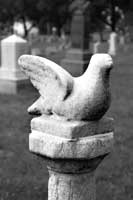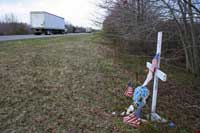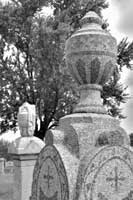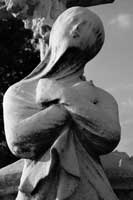This article is part 3 in the three part series on Death Depicted in Cemetery Symbolism. Read part 2.
Mourning Dove
Indigenous to North and Central America, this member of the pigeon family is known for its mournfully plaintive call, “cooOOoo-coo-coo-coo” and the whistling of its wings as it takes flight. It’s interesting that this term came up in our keyword searches for cemetery-related items–I always thought it was morning dove!
 In Christianity, the dove represents the Holy Spirit, but is has had many different cultural meanings throughout history. For instance in Jewish history, a dove was sometimes sacrificed for a mother’s purification after childbirth. In Slavic culture, the soul turns into a dove at the moment of death. In the John Prine song, Jesus, The Missing Years, Jesus takes out his guitar and writes a song called “The Dove of Love Fell off the Perch.”
In Christianity, the dove represents the Holy Spirit, but is has had many different cultural meanings throughout history. For instance in Jewish history, a dove was sometimes sacrificed for a mother’s purification after childbirth. In Slavic culture, the soul turns into a dove at the moment of death. In the John Prine song, Jesus, The Missing Years, Jesus takes out his guitar and writes a song called “The Dove of Love Fell off the Perch.”
Roadside Memorials
 The mourning rituals practiced by today’s fast-moving society are quite novel. Though one rarely feels uplifted by the sad bouquet of soggy stuffed animals tied to the telephone pole, we should respect the fact that people are finding their own ways to deal with loss. Spontaneous memorials like this roadside cross seldom stir up images of a life well spent and a just reward. Rather, they indicate sudden, unexpected, and usually violent death. These are abrupt memorials marking an abrupt loss of life.
The mourning rituals practiced by today’s fast-moving society are quite novel. Though one rarely feels uplifted by the sad bouquet of soggy stuffed animals tied to the telephone pole, we should respect the fact that people are finding their own ways to deal with loss. Spontaneous memorials like this roadside cross seldom stir up images of a life well spent and a just reward. Rather, they indicate sudden, unexpected, and usually violent death. These are abrupt memorials marking an abrupt loss of life.
People take comfort in ritual. These spontaneous memorials honor the memory of the deceased and provide us with ritual closure. Their purpose is no different from a heavily orchestrated church memorial service, though they are much more informal and personal. While spontaneous memorials may be outside the bounds of social decorum, they are free and low-key )sort of like burying your relative’s ashes on the sly, next to the family grave marker).
Further Reading: A Lively Look at the History of Death
Urn -Vessel of the Soul
 I would hazard to guess that urns were the most common sculptural symbol in Victorian-era cemeteries. A Greek symbol of mourning, the urn represents the body as a container of the soul. In ancient Greece, the urn was a repository for the ashes of the dead, so it has quite a literal and functional meaning in a cemetery.
I would hazard to guess that urns were the most common sculptural symbol in Victorian-era cemeteries. A Greek symbol of mourning, the urn represents the body as a container of the soul. In ancient Greece, the urn was a repository for the ashes of the dead, so it has quite a literal and functional meaning in a cemetery.
 Often the urn is draped with a pall (seen in background), a cloth sometimes used to drape a closed casket. A coffin or casket can also be called a pall, by the way (hence pallbearers). The practice of draping is not isolated to urns, as you can see from this image.
Often the urn is draped with a pall (seen in background), a cloth sometimes used to drape a closed casket. A coffin or casket can also be called a pall, by the way (hence pallbearers). The practice of draping is not isolated to urns, as you can see from this image.
Do Not Stand at My Grave and Weep – Further Exploration into the Symbolism of Death
The heading of this final section is the title of Mary Elizabeth Frye’s famous bereavement poem, reprinted below. As lives are concluded, we mourn the loss. Everywhere we look, we are reminded of the deceased, until time heals the wound. We feel it’s unfair to forget them, but we must get on with our lives. Quite possibly, the grave marker serves this purpose for many people. Subconsciously, at least, we officially mark their place on this earth so no one thinks us callous, and then we get on with our lives. Monuments and symbols become coping mechanisms, cemeteries become landscapes of memories. The world becomes a continual reminder of what once was.
Do Not Stand at My Grave and Weep – by Mary Elizabeth Frye
Do not stand at my grave and weep. I am not there; I do not sleep.
I am a thousand winds that blow, I am the diamond glints on snow, I am the sun on ripened grain, I am the gentle autumn rain.
When you wake in the morning’s hush, I am the swift uplifting rush of quiet birds in circled flight. I am the soft stars that shine at night.
Do not stand at my grave and cry, I am not there; I did not die.
The verse has abundant symbolism, all related to the tension between letting go and holding on. While some cemetery symbols we’ve seen in this article can depict both the end as well as a beginning (e.g., the hourglass with wings), we’ve seen others that simply lament the fact that we are mortal. As we wrestle with our own interpretations of symbols, death, and the afterlife, it is best to consider what (the 17th Century English author) John Milton said:
“The mind is its own place, and in itself, can make heaven of Hell, and a hell of Heaven.”
To read more about the psychology of mourning, you may want to read: Remembering Well: Rituals for Celebrating Life and Mourning Death (Hardcover)
by Sarah York
If you ever feel the need to feast on the lion’s share of funerary symbolism, visit Arlington Cemetery’s Mourning Arts Museum in Drexel Hill, PA (outside Philadelphia).